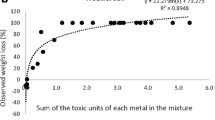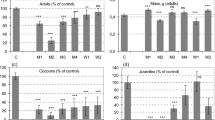Abstract
Three different soils were spiked with 12 different concentrations of inorganic mercury (Hg). Sub-chronic Hg toxicity tests were carried out with Eisenia fetida in spiked soils by exposing the worms for 28 days following standard procedures. The toxicity studies revealed that Hg exerted less lethal effect on earthworms in acidic soil with higher organic carbon (S-3 soil) where water soluble Hg recovery was very low compared to the water soluble Hg fractions in soils with less organic carbon and higher pH (S-1 and S-2 soils). The concentrations of total Hg that caused 50 % lethality to E. fetida (LC50) after 28 days of exposure in S-1, S-2 and S-3 soils were 152, 294 and 367 mg kg−1, respectively. The average weight loss of E. fetida in three soils ranged from 5 to 65 %. The worms showed less weight loss in the organic carbon-rich soil (S-3) compared to less organic carbon containing soils (S-1 and S-2). The bioconcentration of Hg in E. fetida increased with increased Hg concentrations. The highest bioaccumulation took place in the acidic soil with higher organic carbon contents with estimated bioaccumulation factors ranging from 2 to 7.7. The findings of this study will be highly useful for deriving a more robust soil ecological guideline value for Hg.




Similar content being viewed by others
References
Álvarez CR, Moreno MJ, Bernardo FG, Martín-Doimeadios RR, Nevado JB (2014) Mercury methylation, uptake and bioaccumulation by the earthworm Lumbricus terrestris (Oligochaeta). Appl Soil Ecol 84:45–53
Belfroid A, Sijm D, Gestel CV (1996) Bioavailability and toxicokinetics of hydrophobic aromatic compounds in benthic and terrestrial invertebrates. Environ Rev 4:276–299
Burton DT, Turley SD, Fisher DJ, Green DJ, Shedd TR (2006) Bioaccumulation of total mercury and monomethylmercury in the earthworm Eisenia fetida. Wat Air Soil Pollut 170:37–54
Busto Y, Tack F, Cabrera X (2012) Mercury mobility and availability in highly contaminated solid wastes from a chlor-alkali plant. International J Environ Sust Dev 11:3–18
Cáceres TP, Megharaj M, Naidu R (2011) Toxicity and transformation of insecticide fenamiphos to the earthworm Eisenia fetida. Ecotoxicol 20:20–28
Calisi A, Zaccarelli N, Lionetto M, Schettino T (2013) Integrated biomarker analysis in the earthworm Lumbricus terrestris: application to the monitoring of soil heavy metal pollution. Chemosphere 90:2637–2644
CCME (1997) Recommended Canadian soil quality guidelines. http://www.ccme.ca/en/resources/canadian_environmental_quality_guidelines/index.html
CCME (1999) Canadian soil quality guidelines for the protection of environmental and human health. http://www.ccme.ca/en/resources/canadian_environmental_quality_guidelines/index.html
Dang F, Zhao J, Greenfield BK, Zhong H, Wang Y, Yang Z, Zhou D (2015) Soil geochemistry and digestive solubilization control mercury bioaccumulation in the earthworm Pheretima guillemi. J Hazard Mater 292:44–51
Douglas TA, Loseto LL, Macdonald RW, Outridge P, Dommergue A, Poulin A, Amyot M, Barkay T, Berg T, Chetelat J (2012) The fate of mercury in Arctic terrestrial and aquatic ecosystems, a review. Environ Chem 9:321–355
Driscoll CT, Mason RP, Chan HM, Jacob DJ, Pirrone N (2013) Mercury as a global pollutant: sources, pathways, and effects. Environ. Sci. Technol. 47:4967–4983
Du M, Wei D, Tan Z, Lin A, Du Y (2015) Predicted no-effect concentrations for mercury species and ecological risk assessment for mercury pollution in aquatic environment. J Environ Sci 28:74–80
Duan X, Xu M, Zhou Y, Yan Z, Du Y, Zhang L, Zhang C, Bai L, Nie J, Chen G, Li F (2016) Effects of soil properties on copper toxicity to earthworm Eisenia fetida in 15 Chinese soils. Chemosphere 145:185–192
EA (2009) Soil guideline values for mercury in soil: science report SCO50021/Mercury SGV. Environment Agency. https://www.gov.uk/government/publications/land-contamination-soil-guideline-values-sgvs.
Furutani A, Rudd JW (1980) Measurement of mercury methylation in lake water and sediment samples. Appl Environ Microbiol 40:770–776
Garcia E, Orta M, Suarez P (1999) Toxicity assays and bioconcentration of mercury in bacteria selected from marine environments. Bull Environ Contam Toxicol 62:79–86
Gardner WH, Klute A (1986) Water content. Methods of soil analysis. Part 1. Physical and mineralogical methods, 2nd edn. SSSA Inc. and ASA Inc., Madison, WI
Gnamuš A, Byrne AR, Horvat M (2000) Mercury in the soil-plant-deer-predator food chain of a temperate forest in Slovenia. Environ. Sci. Technol. 34:3337–3345
GON (2000) Dutch Target and Intervention Values (the New Dutch List). Government of the Netherlands, Netherlands
Gu B, Bian Y, Miller CL, Dong W, Jiang X, Liang L (2011) Mercury reduction and complexation by natural organic matter in anoxic environments. Proc Nat Acad Sci 108:1479–1483
Hinton JJ, Veiga MM (2009) Using earthworms to assess Hg distribution and bioavailability in gold mining soils. Soil Sed Contam 18:512–524
Jänsch S, Römbke J, Schallnaß H-J, Terytze K (2007) Derivation of soil values for the path ‘soil-soil organisms’ for metals and selected organic compounds using species sensitivity distributions. Environ Sci Pollut Res 14:308–318
Kabata-Pendias A (2010) Trace elements in soils and plants. CRC Press, Boca Raton
Lanno R, Wells J, Conder J, Bradham K, Basta N (2004) The bioavailability of chemicals in soil for earthworms. Ecotoxicol Environ Saf 57:39–47
Lionetto MG, Calisi A, Schettino T (2012) Earthworm biomarkers as tools for soil pollution assessment. INTECH Open Access Publisher
Lock K, Janssen C (2001) Ecotoxicity of mercury to Eisenia fetida, Enchytraeus albidus and Folsomia candida. Biol Fert Soils 34:219–221
Mahbub KR, Krishnan K, Megharaj M, Naidu R (2016) Mercury inhibits soil enzyme activity in a lower concentration than the guideline value. Bull Environ Contam Toxicol 96:76–82
Mason RP, Fitzgerald WF, Morel FM (1994) The biogeochemical cycling of elemental mercury: anthropogenic influences. Geochim Cosmochim Acta 58:3191–3198
McCarty L, Mackay D, Smith A, Ozburn G, Dixon D (1993) Residue-based interpretation of toxicity and bioconcentration QSARs from aquatic bioassays: polar narcotic organics. Ecotoxicol Environ Saf 25:253–270
Melgar M, Alonso J, García M (2009) Mercury in edible mushrooms and underlying soil: bioconcentration factors and toxicological risk. Sci Tot Environ 407:5328–5334
Miller W, Miller D (1987) A micro-pipette method for soil mechanical analysis. Commun Soil Sci Plant Anal 18:1–15
Neculita C-M, Zagury GJ, Deschênes L (2005) Mercury speciation in highly contaminated soils from chlor-alkali plants using chemical extractions. J Environ Qual 34:255–262
NEPM (2013) National Environmental Protection Measure 1999. Schedule B1: guideline on investigation levels for soil and groundwater. doi:http://www.comlaw.gov.au/Details/F2013C00288/Html/Volume_2
Nevado JJB, Martín-Doimeadios RCR, Mateo R, Fariñas NR, Rodríguez-Estival J, Ropero MJP (2012) Mercury exposure and mechanism of response in large game using the Almadén mercury mining area (Spain) as a case study. Environ Res 112:58–66
OECD (1984) OECD guidelines for testing of chemicals n 207, “Earthworm acute toxicity tests”, adopted: 4 April 1984
Pirrone N, Cinnirella S, Feng X, Finkelman RB, Friedli HR, Leaner J, Mason R, Mukherjee AB, Stracher GB, Streets DG (2010) Global mercury emissions to the atmosphere from anthropogenic and natural sources. Atmos Chem Phys 10:5951–5964
Ramadass K, Megharaj M, Venkateswarlu K, Naidu R (2015) Ecological implications of motor oil pollution: earthworm survival and soil health. Soil Biol Biochem 85:72–81
Reis AT, Lopes CB, Davidson CM, Duarte AC, Pereira E (2014) Extraction of mercury water-soluble fraction from soils: an optimization study. Geoderma 213:255–260
Rieder SR, Brunner I, Horvat M, Jacobs A, Frey B (2011) Accumulation of mercury and methylmercury by mushrooms and earthworms from forest soils. Environ Pollut 159:2861–2869
Rodrigues AC, Jesus FT, Fernandes MA, Morgado F, Soares AM, Abreu SN (2013) Mercury toxicity to freshwater organisms: extrapolation using species sensitivity distribution. Bull Environ Contam Toxicol 91:191–196
Sample BE, Suter GW, Beauchamp JJ, Efroymson RA (1999) Literature-derived bioaccumulation models for earthworms: development and validation. Environ Toxicol Chem 18:2110–2120
Sanchez-Hernandez J (2006) Earthworm biomarkers in ecological risk assessment, Rev. Environ. Contam. Toxicol. Springer, Berlin Heidelberg New York, pp. 85–126
Skyllberg U (2012) Chemical speciation of mercury in soil and sediment, Environmental Chemistry and Toxicology of Mercury. Wiley, New York
Skyllberg U, Bloom PR, Qian J, Lin C-M, Bleam WF (2006) Complexation of mercury (II) in soil organic matter: EXAFS evidence for linear two-coordination with reduced sulfur groups. Environ Sci Technol 40:4174–4180
Sloss L (2012) Legislation, standards and methods for mercury emissions control CCC/195 London, UK, IEA Clean Coal Centre 43
Stein ED, Cohen Y, Winer AM (1996) Environmental distribution and transformation of mercury compounds. Crit Rev Environ Sci Technol 26:1–43
Tipping E, Lofts S, Hooper H, Frey B, Spurgeon D, Svendsen C (2010) Critical limits for Hg (II) in soils, derived from chronic toxicity data. Environ Pollut 158:2465–2471
USEPA (2015) Regional Screening Level (RSL) Summary Table (TR = 1E-6, HQ = 1) June 2015 (revised). USA
Wu Y, Wang W-X (2014) Intracellular speciation and transformation of inorganic mercury in marine phytoplankton. Aq Toxicol 148:122–129
Yuan Q, Guoqing Z, Wenxiang H (2012) Effects of Hg on soil enzyme. J Northwest Agric Forest Univ 40:191–198
Zagury GJ, Neculita CM, Bastien C, Deschênes L (2006) Mercury fractionation, bioavailability, and ecotoxicity in highly contaminated soils from chlor-alkali plants. Environ Toxicol Chem 25:1138–1147
Zhang ZS, Zheng DM, Wang QC, Lv XG (2009) Bioaccumulation of total and methyl mercury in three earthworm species (Drawida sp., Allolobophora sp., and Limnodrilus sp.). Bull Environ Contam Toxicol 83(6):937–942
Acknowledgments
The research was funded by the Cooperative Research Centre for Contamination Assessment and Remediation of the Environment (CRC-CARE) in collaboration with Global Centre for Environmental Remediation, Faculty of Science and Information Technology, The University of Newcastle. The funding was provided as PhD scholarship to KRM.
Author information
Authors and Affiliations
Corresponding author
Additional information
Responsible editor: Henner Hollert
Rights and permissions
About this article
Cite this article
Mahbub, K.R., Krishnan, K., Naidu, R. et al. Mercury toxicity to Eisenia fetida in three different soils. Environ Sci Pollut Res 24, 1261–1269 (2017). https://doi.org/10.1007/s11356-016-7869-5
Received:
Accepted:
Published:
Issue Date:
DOI: https://doi.org/10.1007/s11356-016-7869-5




